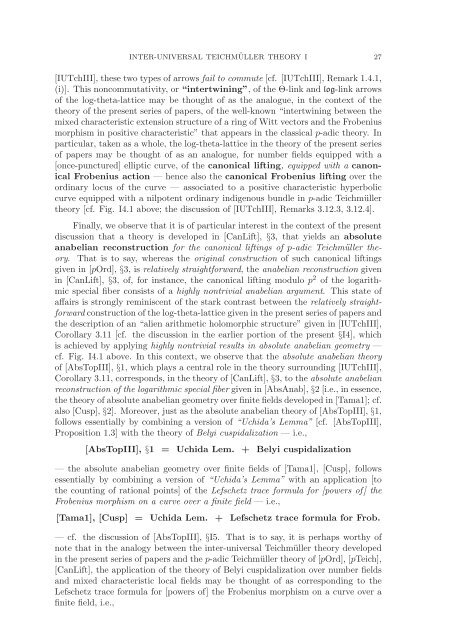Inter-universal Teichmuller Theory I: Construction of Hodge Theaters
Inter-universal Teichmuller Theory I: Construction of Hodge Theaters
Inter-universal Teichmuller Theory I: Construction of Hodge Theaters
Create successful ePaper yourself
Turn your PDF publications into a flip-book with our unique Google optimized e-Paper software.
INTER-UNIVERSAL TEICHMÜLLER THEORY I 27<br />
[IUTchIII], these two types <strong>of</strong> arrows fail to commute [cf. [IUTchIII], Remark 1.4.1,<br />
(i)]. This noncommutativity, or “intertwining”, <strong>of</strong> the Θ-link and log-link arrows<br />
<strong>of</strong> the log-theta-lattice may be thought <strong>of</strong> as the analogue, in the context <strong>of</strong> the<br />
theory <strong>of</strong> the present series <strong>of</strong> papers, <strong>of</strong> the well-known “intertwining between the<br />
mixed characteristic extension structure <strong>of</strong> a ring <strong>of</strong> Witt vectors and the Frobenius<br />
morphism in positive characteristic” that appears in the classical p-adic theory. In<br />
particular, taken as a whole, the log-theta-lattice in the theory <strong>of</strong> the present series<br />
<strong>of</strong> papers may be thought <strong>of</strong> as an analogue, for number fields equipped with a<br />
[once-punctured] elliptic curve, <strong>of</strong> the canonical lifting, equipped with a canonical<br />
Frobenius action — hence also the canonical Frobenius lifting over the<br />
ordinary locus <strong>of</strong> the curve — associated to a positive characteristic hyperbolic<br />
curve equipped with a nilpotent ordinary indigenous bundle in p-adic Teichmüller<br />
theory [cf. Fig. I4.1 above; the discussion <strong>of</strong> [IUTchIII], Remarks 3.12.3, 3.12.4].<br />
Finally, we observe that it is <strong>of</strong> particular interest in the context <strong>of</strong> the present<br />
discussion that a theory is developed in [CanLift], §3, that yields an absolute<br />
anabelian reconstruction for the canonical liftings <strong>of</strong> p-adic Teichmüller theory.<br />
That is to say, whereas the original construction <strong>of</strong> such canonical liftings<br />
given in [pOrd], §3, is relatively straightforward, theanabelian reconstruction given<br />
in [CanLift], §3, <strong>of</strong>, for instance, the canonical lifting modulo p 2 <strong>of</strong> the logarithmic<br />
special fiber consists <strong>of</strong> a highly nontrivial anabelian argument. This state <strong>of</strong><br />
affairs is strongly reminiscent <strong>of</strong> the stark contrast between the relatively straightforward<br />
construction <strong>of</strong> the log-theta-lattice given in the present series <strong>of</strong> papers and<br />
the description <strong>of</strong> an “alien arithmetic holomorphic structure” given in [IUTchIII],<br />
Corollary 3.11 [cf. the discussion in the earlier portion <strong>of</strong> the present §I4], which<br />
is achieved by applying highly nontrivial results in absolute anabelian geometry —<br />
cf. Fig. I4.1 above. In this context, we observe that the absolute anabelian theory<br />
<strong>of</strong> [AbsTopIII], §1, which plays a central role in the theory surrounding [IUTchIII],<br />
Corollary 3.11, corresponds, in the theory <strong>of</strong> [CanLift], §3, to the absolute anabelian<br />
reconstruction <strong>of</strong> the logarithmic special fiber given in [AbsAnab], §2 [i.e., in essence,<br />
the theory <strong>of</strong> absolute anabelian geometry over finite fields developed in [Tama1]; cf.<br />
also [Cusp], §2]. Moreover, just as the absolute anabelian theory <strong>of</strong> [AbsTopIII], §1,<br />
follows essentially by combining a version <strong>of</strong> “Uchida’s Lemma” [cf. [AbsTopIII],<br />
Proposition 1.3] with the theory <strong>of</strong> Belyi cuspidalization — i.e.,<br />
[AbsTopIII], §1 = Uchida Lem. + Belyi cuspidalization<br />
— the absolute anabelian geometry over finite fields <strong>of</strong> [Tama1], [Cusp], follows<br />
essentially by combining a version <strong>of</strong> “Uchida’s Lemma” with an application [to<br />
the counting <strong>of</strong> rational points] <strong>of</strong> the Lefschetz trace formula for [powers <strong>of</strong>] the<br />
Frobenius morphism on a curve over a finite field — i.e.,<br />
[Tama1], [Cusp] = Uchida Lem. + Lefschetz trace formula for Frob.<br />
— cf. the discussion <strong>of</strong> [AbsTopIII], §I5. That is to say, it is perhaps worthy <strong>of</strong><br />
note that in the analogy between the inter-<strong>universal</strong> Teichmüller theory developed<br />
in the present series <strong>of</strong> papers and the p-adic Teichmüller theory <strong>of</strong> [pOrd], [pTeich],<br />
[CanLift], the application <strong>of</strong> the theory <strong>of</strong> Belyi cuspidalization over number fields<br />
and mixed characteristic local fields may be thought <strong>of</strong> as corresponding to the<br />
Lefschetz trace formula for [powers <strong>of</strong>] the Frobenius morphism on a curve over a<br />
finite field, i.e.,
















